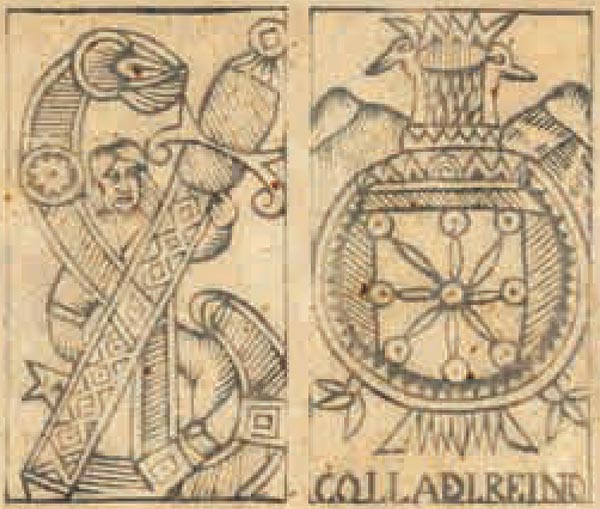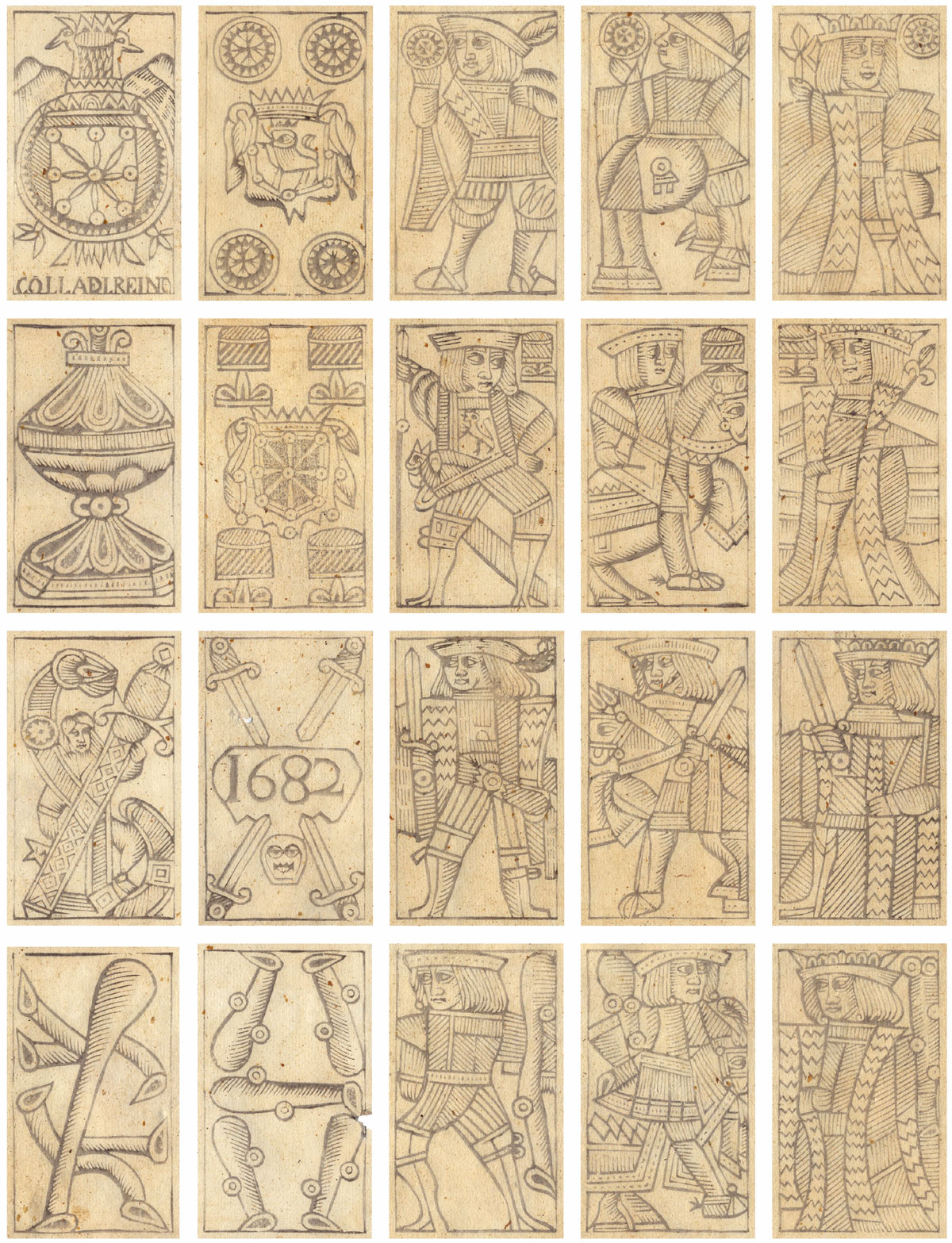Navarra Pattern, 1682
Navarra pattern produced for the Pamplona General Hospital Monopoly in 1682.
Playing cards produced for the Pamplona General Hospital Monopoly in 1682 representing the archaic ‘Navarra Pattern’, for use in the kingdom of Navarra. The designs became established as a regional pattern as the monopoly contract was renewed over time. Thus, cards could be differentiated from those of neighbouring kingdoms or tax jurisdictions.
It is likely that wooblocks, and even completed packs of cards, were produced in France for the Pamplona General Hospital since 1631, which explains why the designs contain features common to earlier or archaic French cards.

Above: the ace of coins features the coat of arms of Navarra with a double-headed eagle and the inscription CON L(A) L(ICENCI)A DEL REINO.

Above: cards from 4 separate proof sheets comprising a full pack of 48 cards produced for the Pamplona General Hospital Monopoly in 1682. Each card measures 50 x 84 mm. The sheets were discovered inside the binding of an old book, having presumably been rejected during manufacture and re-used as stiffening for the book covers. The watermark in the paper features the coat of arms of Amsterdam, which was used in France and Holland for products destined for exportation during the period 1635-1796. The cards do not have the ‘pintas’ (border breaks) usually found in Spanish playing cards after c.1600, which lends support to the argument for a French origin of the woodblocks.
CREDITS & REFERENCES
Ferro Torrelles, Víctor: Unos Naipes para el Reino de Navarra, in “La Sota” Nº44, Asescoin, Madrid.
Additional research by Alberto Pérez González.

By Simon Wintle
Member since February 01, 1996
I am the founder of The World of Playing Cards (est. 1996), a website dedicated to the history, artistry and cultural significance of playing cards and tarot. Over the years I have researched various areas of the subject, acquired and traded collections and contributed as a committee member of the IPCS and graphics editor of The Playing-Card journal. Having lived in Chile, England, Wales, and now Spain, these experiences have shaped my work and passion for playing cards. Amongst my achievements is producing a limited-edition replica of a 17th-century English pack using woodblocks and stencils—a labour of love. Today, the World of Playing Cards is a global collaborative project, with my son Adam serving as the technical driving force behind its development. His innovative efforts have helped shape the site into the thriving hub it is today. You are warmly invited to become a contributor and share your enthusiasm.
Related Articles

Pierre Varangot
Tracing the origins, legality and legacy of Pierre Varangot’s San Sebastián deck.

Archaic Spanish-suited pattern from Bayonne
Archaic Franco-Spanish pattern from Bayonne by a manufacturer with the initals M.V.

French Revolutionary cards by Pinaut
Seven cards from a French Revolutionary pack by Pinaut featuring characters from classical antiquity...

Tarot de las Coscojas
Historical playing card design, tarot symbolism and an almost psychedelic medieval surrealism.

Tarot de Valverde de la Vera
A series of 24 surrealist engravings by Mexican artist Claudio Favier in which archetypal Tarot alle...

Baraja de Juan Martín Zamorano
Deck inspired by El Pendón de los Zamorano, a military pennant dating from 1501, published by Priego...

Heráldica Castanyer No. 16
Strange variant of international pattern cards for poker or bridge.

Fantasy Spanish-suited deck
Fantasy Spanish-suited deck by Bertschinger y Codina, Barcelona.

Trappola cards from Poland
Trappola cards published in Warsaw by J G Du Port during the 18th century.

Bertschinger y Codina - Cartes Françaises
French ‘Paris’ pattern made by Bertschinger y Codina, Barcelona, c.1850.

Braulio Fournier
Baraja Nº 1 produced by Braulio Fournier, Burgos, c.1868.

Pirritx eta Porrotx
Happy Families card game from the Spanish Basque Country.

Naipe Vizcaino
‘Naipe Vizcaino’ designed by Javier Urkiri and published by Industrias Gráficas Castuera and the Caj...

Baraja Turística del País Vasco
Basque poker deck of 55 cards published by Fournier with scenic views of the Basque Country.

Baraja Vasca
Spanish Basque Country deck with original drawings by María Isabel Ibañez de Sendadiano.

Baraja Cultura Española
ASESCOIN pack for 2022 designed by M.A. Corella featuring famous Spaniards and notable buildings.
Most Popular
Our top articles from the past 28 days

